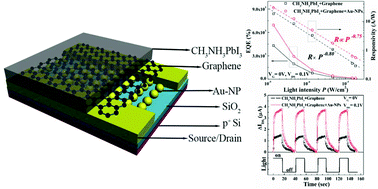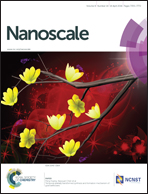Plasmonic-enhanced perovskite–graphene hybrid photodetectors†
Abstract
The surface plasmonic effect of metal nanostructures is a promising method to boost the performance of optoelectronic devices such as solar cells and photodetectors. In this report, gold nanoparticles with surface plasmon resonance localized at about 530 nm were synthesized and integrated into graphene/methylammonium lead iodide perovskite (CH3NH3PbI3) hybrid photodetectors. Compared with pristine graphene–CH3NH3PbI3 devices, a device with gold nanoparticles embedded has a doubly higher photo-responsivity as well as a faster photoresponse speed. The present devices adopt a unique configuration with gold nanoparticles physically separated from the light harvesting component, i.e., the perovskite layer by graphene. Advantages are revealed through a series of characterization techniques and analyses. First, thanks to the tiny thickness of graphene, the plasmonic effect of gold nanoparticles can effectively enhance the near-field of perovskite and thus facilitate light-harvesting. Second, the enhanced light-harvesting in perovskite happens very close to this interface where photo-induced carriers have relatively short paths to diffuse toward graphene, favoring a fast photo-response. This work demonstrates a feasible and inspiring strategy to improve the performance of photodetectors through the surface plasmonic effect of metallic nanostructures.


 Please wait while we load your content...
Please wait while we load your content...